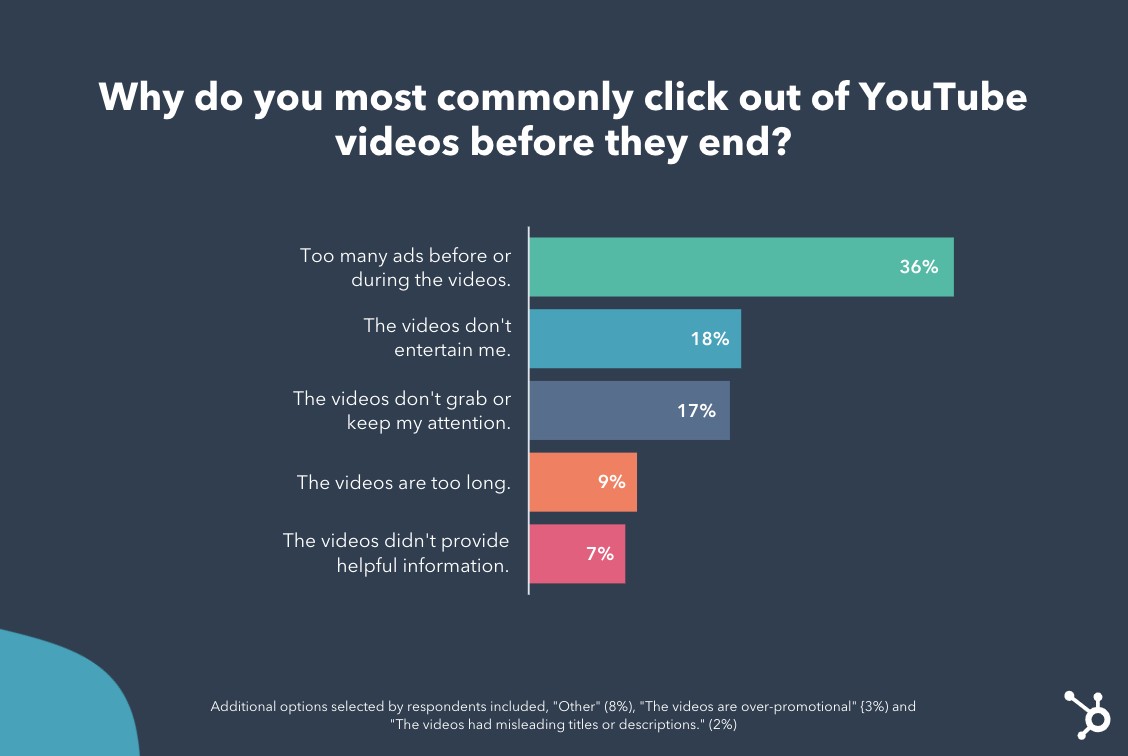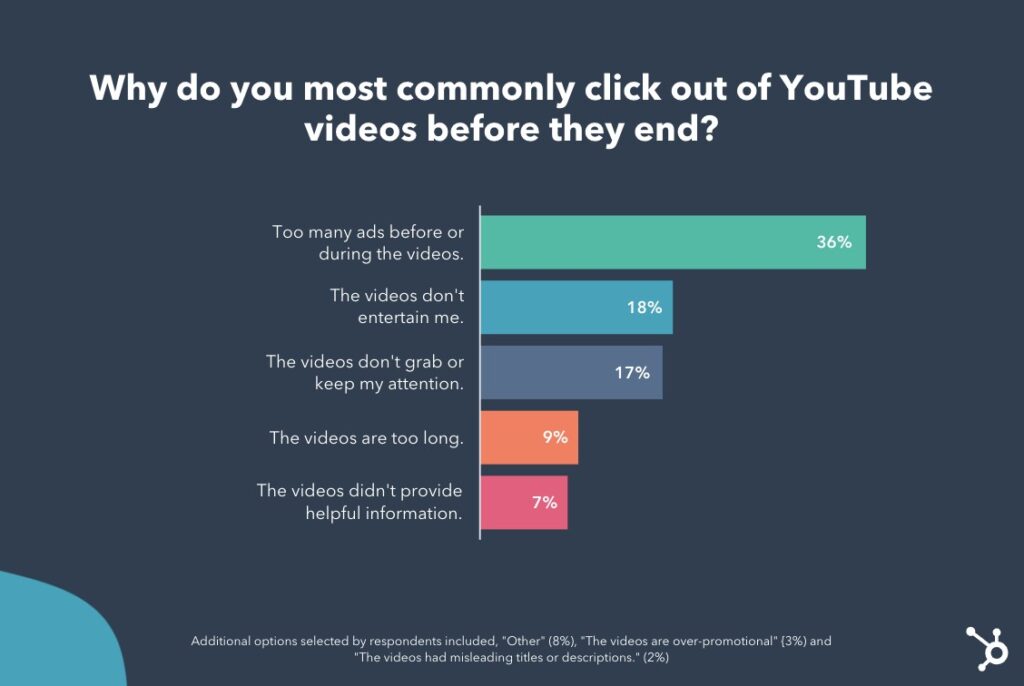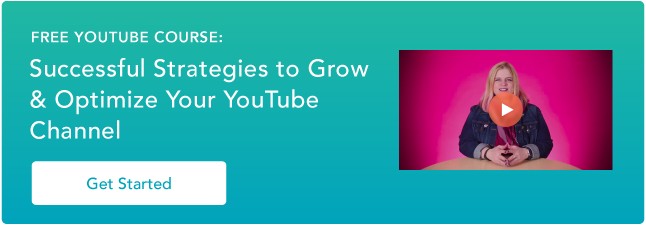With more than 2 billion active users -- or nearly one-third of the global internet audience -- YouTube has become a vital platform used within most video marketing strategies.
But, as one of the biggest online platforms, YouTube is also one of the most competitive for brands. For every YouTube channel related to a specific industry, there are a handful of others churning out similar content.
To rise above YouTube's fierce competition, you'll need to regularly create content that grabs your viewers' attention and keeps them engaged.
Ultimately, if viewers disengage with your YouTube videos, they'll click out of them before they end and find better content from another channel.
Before you begin producing content, it's important to ask yourself, "Why do consumers click out of YouTube videos?"
To help video marketers answer the question above, I used Lucid software to ask nearly 300 consumers why they disengage from YouTube videos.
Why Consumers Click Out of YouTube Videos
After taking time to film, edit, upload, and optimize videos, it can be frustrating to see a heavy viewer dropoff before the content ends. Not only can this trend hurt your YouTube engagement metrics, but it's also a sign that you're wasting valuable time and money making content that people aren't even going to finish.
But, while higher dropoff rates are often a sign of content disengagement, it's important to note that -- sometimes -- video exits aren't a creator's fault.
When I asked consumers, "Why do you most commonly click out of YouTube videos before they end?", more than one-third of respondents, or 36%, said they drop out because "too many ads" play before or in the middle of videos.

Below, we'll dive into the top response, like the one noted above, to help you create the most engaging YouTube video viewing experience.
1. Too many ads appear before or during videos.
While there's not much some creators can do about ad placement at the very beginning and end of their YouTube videos, mid-roll ads -- which appear by default in videos that are eight minutes or longer -- can be turned off in your YouTube settings.
If you're trying to monetize your content by enabling more mid-roll YouTube ads, you'll want to weigh the pros and cons of this type of ad. While you might earn more money for your content, this ad placement could also be a major friction point that causes your viewers to click out of your video.
Additionally, if you do opt to include mid-roll ads, you should take steps to make sure your video is intriguing, valuable, or exciting enough to keep the viewer watching -- even with a short ad break.
To create engaging videos that will be less vulnerable to ad-related dropoff, keep reading to see the content-related reasons people click out of YouTube content.
2. Videos aren't entertaining or attention-grabbing
While 18% of respondents tune out of videos that "don't entertain" them, 17% click out of content that fails to "get and keep" their attention. While the respondents' need for entertainment lines up with YouTube's research showing consumers watch videos to relax or "escape" from their daily lives, the need for attention-grabbing content lines up with countless video and social media data.
While most audience's don't expect B2C or B2B brand content to be as entertaining as videos from musicians, television studios, or influencers, you should still test out video storytelling approaches that place your viewers into an action-packed, intriguing, or funny scene to get them to invest their attention. Then, once you hook them, you can continue to include interesting information or scenes in your content to keep them watching.
But how can you entertain and intrigue your audience while still highlighting the selling points of your brand, product, or service? Here's a great example of a brand that does this incredibly well.
In this episode of Purple's video series, "The Purple Boys," two mock talk-show hosts, played by comedians Tim Heidecker and Eric Wareheim, tell an over-dramatic story about the "Sunday Scaries."
The video begins with Heidecker waking up in his host chair. He then abruptly starts screaming due to the Sunday Scaries -- or the stresses felt on Sundays before a workweek begins.
As the video continues, viewers learn what the Sunday Scaries are, hear one man tell his story of them, and learn how the Purple mattress helped him sleep even when dealing with the stresses of the upcoming week. To prevent any dull moments, the editors also added strange sound and visual effects to represent what the Sunday Scaries feel like.
This is a great example of how a brand used video to tell an intriguing, dramatic, yet still relatable, story related to a common consumer pain point. At the same time, Purple's video also explains how its product could help. Not only will this content keep viewers watching, but it might also cause them to remember the Purple brand next time they need a sleep accessory or mattress.
3. Videos are too long.
Sometimes, even if you have great content, viewers can only pay attention for so long -- especially on a fast-paced platform like YouTube. That's why nearly 10% of respondents cited length for tuning out of a YouTube video.
While some people might be watching videos during a break at work, others might watch on their smartphones during a daily commute. Aside from this, research shows that each new generation has seen a slightly shorter attention span when it comes to online content.
If you feel like you're creating genuinely compelling content, but see viewer dropoff, take note of when the biggest chunks of viewers tune out of your videos.
If viewers regularly drop off at around the same minute-mark for each video, consider adjusting your strategy to create shorter, more concise videos. You can also find some helpful guidelines in this blog post.
Creating Engaging Long-Form YouTube Videos
While length can be the culprit of video dropoff, the small segment of consumers that cited it shouldn't scare you away from testing long-form content. Although the data above hints that some consumers dislike long video content, data directly from YouTube shows that certain age groups, such as Gen-Z, are watching more long-form content on the platform than they did in previous years.
Additionally, a number of successful brands, Including HubSpot, regularly embraces long-form content on platforms like YouTube,
If you want to leverage long-form content, but still worry about video dropoff, consider placing the most valuable information towards the beginning of the video -- or give viewers a tease of what they'll see if they continue watching. This way, if viewers don't have time to watch your whole video, they'll get to see your expertise in action and they'll have a motive to come back later if they need to pause.
One example of a brand that knows how to draw viewers into the action of a long-form video and then keep their attention is Patagonia.
For example, the 27-minute Patagonia documentary below opens with clips of a mountain climber in action and a brief narration from him saying, "As a veteran, you feel like 'I've really narrowed that gap and I can perceive what nature's telling me. I can read the signs around me.'"
Suddenly, after the hiker's initial narration, you see an intense clip -- shot from his perspective -- of him yelling as he gets caught in an avalanche.
When the screen fades to black, and viewers see the film's title, along with "Full Film Starts Now," they realize they've only gotten a glimpse of the action they'll see later on.
Patagonia's branded documentaries and video teasers are a great example of how a brand can persuade viewers to stick through even the longest types of YouTube videos. When the video reopens, viewers will likely want to continue watching so they can hear the full story and get the context behind the intense scene they just saw.
4. Videos don't provide helpful information.
Although only 7% of respondents primarily click out of videos that aren't providing helpful information, this is still important to call out.
While consumers might use YouTube to learn how to do something, study up on a hobby or interest, or learn more about their favorite influencers, others use it to get more information about companies or industries. In fact, YouTube research shows that consumers increasingly use YouTube to learn about products, services, and brands.
Regardless of what kind of content you make, consider providing valuable or educational information in it so users feel like they're learning something new. If you do this, viewers might continue watching your videos until the end with the assumption that they'll continue to gain valuable insight from you. Additionally, your viewers might also identify your brand as a thought leader they can go to for more helpful videos in the future.
Need an example of how to offer viewers valuable or educational information in a video?
Check out the HubSpot video below which highlights Instagram hacks for businesses. While the video serves as a detailed list of tips related to the trendy social platform, it also naturally mentions one of HubSpot's free Instagram templates:
5. Other reasons people click out of YouTube videos.
While 8% of consumers said, "Other," 3% said "The videos felt over-promotional," and 2% said, "The content isn't consistent with video headlines or descriptions."
Keep YouTube Viewers Watching
While you might not have been shocked by some of the responses above, they reaffirm that video marketers need to take extra steps to engage their viewers while also promoting their brand. Although you might like to think that commercials or heavily promotional videos might be the best way to sell products, they might not yield high engagement or YouTube audience growth.
As you create your next video, keep these tips in mind to help prevent high dropoff:
- Hook your viewers: Start with intriguing information or an attention-grabbing scene, or tease viewers about what's to come.
- Provide value: Be sure to provide interesting information, educational dialogue, or points of action throughout the video as well as at the beginning to keep viewers engaged.
- Don't draw things out: If you can concisely get your point across in a short amount of time, opt for a shorter rather than longer video.
To learn more about how to succeed on YouTube, check out this recent research, or this ultimate guide. You can also click below to download a helpful free resource.


